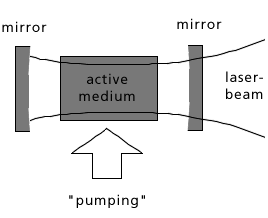The word LASER is an acronym which stands for Light Amplification by Stimulated Emission of Radiation. It actually represents the principle itself but is nowadays also used to describe the source of the laser beam. The main components of a laser are the laser active, light amplifying medium and an optical resonator which usually consists of two mirrors.
Laser Tutorial
The first laser was constructed in 1960 by Theodore Maiman - it consisted of a ruby laser stimulated by a flash bulb. There are
now many and various ways in which the principle of laser operation can be realised:
some lasers are not even a mm long while some laser systems fill entire buildings; power outputs vary between nW and TW
(10-9 - 1012 W). Maiman’s ruby laser emitted light in the red spectral range at 694 nm - we now know of laser media
which can emit wavelengths from several hundred m m to a few nm in the soft x-ray region. The wavelength and output power of
any particular laser are defined by the application for which they are intended. Lasers are used in a wide variety of applications, such as:
- Optoelectronics
CD players and CD-ROM drives (semiconductor lasers)
Data transfer via fibre optic cables
- Medicine
Ophthalmology
Dermatology
- Measurement & instrumentation
Mining and tunnel surveying
Measurement of workpiece surfaces
Analysis (e.g. in mobile environmental analysis equipment)
- Manufacturing technology
Cutting
Welding
Surface treatment etc.
- Research
Laser fusion
Diagnostics
Measurement of earth-moon distance
 Fraunhofer Institute for Laser Technology ILT
Fraunhofer Institute for Laser Technology ILT